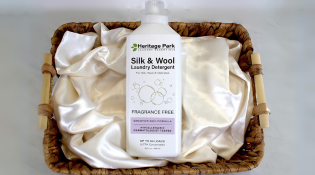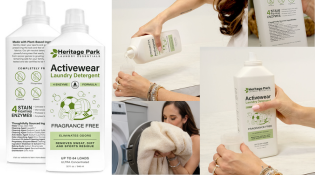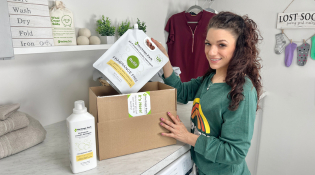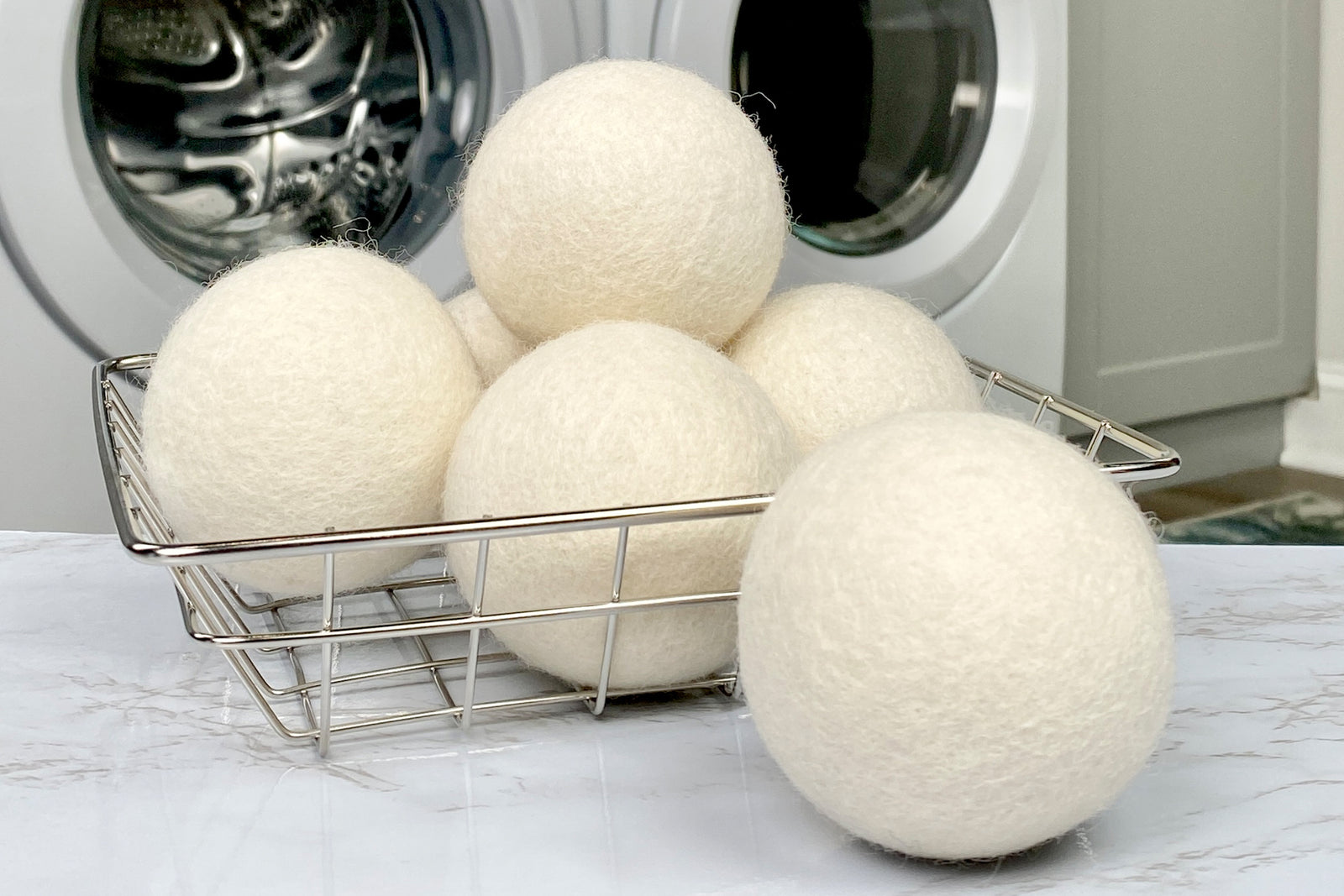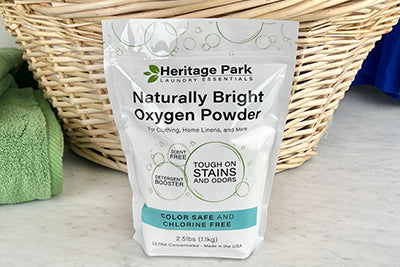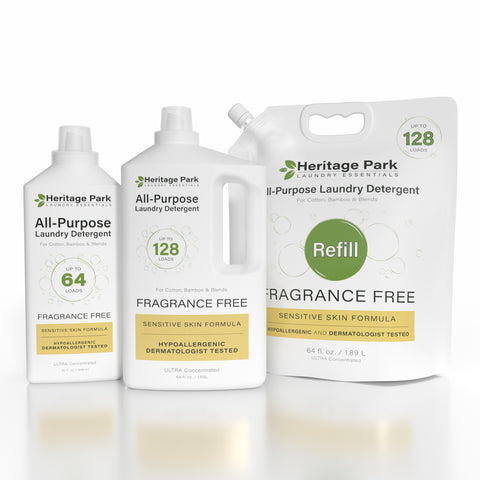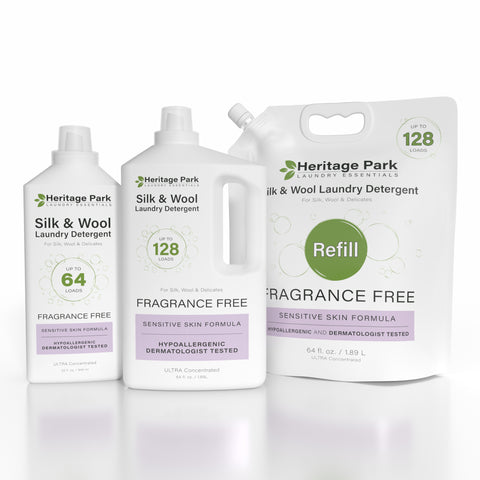Laundry detergent allergy is more common than most people realize — hidden irritants in products labeled "sensitive" or "hypoallergenic" may be the culprit.
If you're experiencing unexplained rash, skin irritation, or allergic reactions that seem to come and go without warning, your laundry detergent might be the culprit. Many products labeled as "hypoallergenic" or "sensitive" still contain problematic ingredients that can trigger laundry detergent allergies and contact dermatitis.
Key Takeaways
|
The Shocking Truth About "Sensitive" Laundry Detergent Labels
Laundry detergent allergy is more common than most people realize, affecting millions who experience contact dermatitis, allergic contact dermatitis, and irritant contact dermatitis from everyday laundry products. What's particularly troubling is that even detergents that appear to be safe for sensitive skin still contain hidden ingredients that can trigger severe allergic reactions.
Laundry Detergent Labels Can Be Misleading
The problem lies in misleading labeling practices. Terms like "gentle," "sensitive," and even "hypoallergenic" aren't regulated by the FDA for laundry products, meaning manufacturers can use these claims while still including allergens that cause rash, itching, and dermatitis. This deceptive marketing leaves consumers vulnerable to laundry detergent allergies they never saw coming.

Detergent Allergy Comes with a Range of Symptoms
Detergent allergy symptoms can manifest as allergic reactions ranging from mild skin irritation to severe contact dermatitis that requires medical treatment. Common symptoms include itchy rash, redness, swelling, and burning sensations. People with atopic dermatitis are particularly vulnerable to these reactions. The rash often appears where clothes fit tightly against the skin, making it difficult for sufferers to identify their laundry detergent as the source of their skin allergy.
Hidden Allergens Lurking in Your Detergent
Dangerous Surfactants and Cleaning Agents
Sodium Lauryl Sulfate (SLS) is a potential irritant that often appears in detergents marketed for sensitive skin. Sodium Lauryl Sulfate can weaken the skin's natural protective barrier, making it more susceptible to allergic reactions and irritant contact dermatitis. Despite causing well-documented skin irritation and itchy rash, SLS continues to appear in detergents because it creates the foaming action consumers expect.
C10-16 Pareth, a synthetic surfactant with moderate to high irritation potential, frequently appears in traditional detergent formulations. This potential allergen can cause allergic contact dermatitis in sensitive individuals, yet it's rarely highlighted on product labels as a concern.
Sodium C10-16 Alkyl Benzene Sulfonate is another known skin irritant that manufacturers often include in detergent formulations. This synthetic cleaning agent can trigger laundry detergent rash and worsen existing dermatitis conditions, including eczema.
Preservatives That Trigger Allergic Reactions
Methylisothiazolinone represents one of the most concerning preservatives found in laundry products. This chemical can cause significant allergic reactions and has been linked to increased rates of contact dermatitis. Repeated exposure through clothes and bedding can sensitize the skin over time, leading to more severe allergic reactions.
Polyethylene Imines Alkoxylated serves as a synthetic polymer thickener but acts as a potential allergen for many people with detergent allergies. This ingredient can remain as detergent residue on clothes even after rinsing, creating ongoing skin irritation.
Sodium Cumenesulfonate, a synthetic solubilizer, can trigger skin irritation and allergic reactions in sensitive individuals. Despite its irritation potential, this ingredient appears in many detergents marketed as gentle alternatives.

Hidden Contaminants Not Listed on Labels
Perhaps most concerning are the contaminants that form during manufacturing but never appear on ingredient lists. 1,4-Dioxane is a carcinogenic byproduct that can form when certain surfactants are processed. This contaminant has been found in numerous laundry detergent products, including some marketed for sensitive skin, yet consumers have no way of knowing about its presence.
Formaldehyde-releasing preservatives represent another hidden danger. These compounds slowly break down over time, releasing formaldehyde that can cause allergic reactions and contact dermatitis. Since the preservative itself is listed rather than the formaldehyde it releases, consumers remain unaware of this potential allergen.
Optical Brighteners: The Invisible Allergen
Optical brighteners make clothes appear whiter and brighter, but they leave residue on fabric that can cause skin irritation and allergic reactions. These chemicals absorb UV light and reflect blue light, creating the illusion of cleaner clothes while potentially triggering laundry detergent allergies. Many people with contact dermatitis don't realize that optical brighteners in their detergent could be the source of their rash.
The Critical Difference: "Unscented" vs. "Fragrance-Free"
Another misleading labeling practice involves fragrance. Many consumers assume that "unscented" detergent means no fragrance ingredients, but this couldn't be further from the truth.
"Unscented" Products May Still Contain Allergens
Detergents labeled as "unscented" often contain masking fragrances designed to neutralize the chemical smell of cleaning agents. These masking compounds, which are essentially artificial fragrances, can trigger allergic reactions just as readily as traditional fragrances. For people with detergent allergies and skin allergy, "unscented" products can be just as problematic as scented versions.
The fragrance industry isn't required to disclose the specific chemicals used in fragrance blends, meaning "unscented" products can contain dozens of undisclosed potential allergens. This lack of transparency makes it impossible for consumers with laundry detergent allergies to avoid specific triggers that cause skin allergy and allergic reactions.
Look for Genuine "Fragrance-Free" Formulations
Genuinely fragrance-free detergents like Heritage Park's formulas contain NO no added fragrances of any kind, including masking agents, essential oils, or synthetic fragrance compounds. This distinction is crucial for people prone to allergic contact dermatitis, laundry detergent rash, and atopic dermatitis.
Heritage Park All-Purpose Fragrance-Free Laundry Detergent represents true fragrance-free formulation, containing zero fragrance ingredients that could trigger allergic reactions. This transparency helps consumers with detergent allergy avoid irritation and contact dermatitis.
Understanding EWG and Why Verification Matters
The Environmental Working Group (EWG) is a non-profit organization that researches the safety of consumer products and ingredients. Founded in 1993, EWG evaluates laundry products, soap, and other household items for potential allergens, carcinogens, and other health concerns.
What EWG VERIFIED Means
EWG VERIFIED® represents the gold standard for ingredient transparency and safety. To earn this certification, products must:
- Contain no EWG ingredients of concern with human health implications
- Meet full transparency requirements for all ingredients, including fragrance components
- Follow science-based criteria created by EWG's team of scientists and toxicologists
- Undergo rigorous third-party evaluation
Only the top 2.5% of products in EWG's database earn this elite designation, making EWG VERIFIED® products the safest choice for consumers with laundry detergent allergies.
Why EWG Verification Helps You Avoid Detergent Allergy
EWG's comprehensive ingredient screening eliminates hidden chemicals and potential allergens that cause allergic reactions and contact dermatitis. Unlike manufacturers' own claims about safety, EWG verification requires independent scientific review of every ingredient.
For people with dermatitis and laundry detergent allergies, EWG verification provides confidence that hidden allergens won't trigger allergic reactions or worsen existing skin irritation.
Hidden Laundry Detergent Allergy Comparison Table
|
Ingredient Category |
Common Hidden Allergens |
Found In |
Health Concerns |
|
Surfactants |
Sodium Lauryl Sulfate, C10-16 Pareth |
Most traditional detergents |
Contact dermatitis, skin irritation |
|
Preservatives |
Methylisothiazolinone, Formaldehyde-releasers |
"Sensitive" detergents |
Allergic reactions, dermatitis |
|
Fragrance |
Masking agents, undisclosed compounds |
"Unscented" products |
Allergic contact dermatitis |
|
Brighteners |
Optical brightening agents |
Mainstream laundry detergent |
Skin irritation, rash |
|
Contaminants |
1,4-Dioxane, Heavy metals |
Various detergents |
Allergic reactions, long-term health risks |
Heritage Park: Transparent Protection Against Laundry Detergent Allergy
Heritage Park All-Purpose Laundry Detergent Fragrance Free and Heritage Park Silk and Wool Detergent Fragrance Free stand apart from misleading "sensitive" products through genuine transparency and EWG VERIFIED® certification. These hypoallergenic detergents eliminate known allergens that cause laundry detergent allergies while maintaining superior cleaning power.
Unlike traditional detergent that may remove some problematic ingredients while retaining others, Heritage Park was formulated from the ground up to prevent allergic reactions and contact dermatitis. The liquid detergent contains:
- No synthetic surfactants that cause skin irritation
- No preservatives linked to allergic reactions
- No optical brighteners that trigger dermatitis
- No hidden contaminants or undisclosed allergens
- No masking fragrances or fragrance compounds of any kind
- Gentle, pH-neutral formula
- A short list of natural and naturally derived ingredients
Clinical Evidence of Safety
Heritage Park's hypoallergenic detergents have undergone comprehensive 50 Human Subject Repeat Insult Patch Testing (RIPT) with zero allergic reactions. This clinical evidence proves the detergent won't cause allergic contact dermatitis or irritant contact dermatitis in sensitive individuals.
The liquid laundry detergent is both dermatologist and pediatrician tested, ensuring safety for all family members prone to laundry detergent allergies. This medical endorsement provides confidence that the detergent won't trigger rash, itching, or other allergy symptoms.
EWG VERIFIED Transparency
Heritage Park's EWG VERIFIED® status guarantees complete ingredient transparency and elimination of all potential allergens identified by EWG scientists. This third-party certification means consumers can trust that hidden allergens won’t cause unexpected allergic reactions or worsen existing dermatitis.
The verification process requires disclosure of every ingredient, including processing aids and trace contaminants that could trigger detergent allergy. This level of transparency is the gold standard in the laundry detergent industry.
Real Customer Experiences: Freedom from Detergent Allergy
Sheryl F., who suffers from contact dermatitis, shares: "Works great, doesn't trigger my contact dermatitis, WIN-WIN! As I said in the title, I have contact dermatitis. Yeah, all the sulfates, artificial colors and scents, parabens, and many other chemicals they call 'safe' will break me out in horrible painful, itchy bumps everywhere. So, this doesn't do that! It works great on my laundry and they smell and feel and look clean while only using a half capful per load on my HE washing machine!"
Jennifer H. experienced relief: "My skin stopped itching once I started using Excellent Quality products."
These testimonials demonstrate how making Heritage Park Fragrance Free detergents a part of your skin-safe laundry routine can help minimize laundry detergent allergies and allergic reactions.
Break Free from Hidden Allergens with Heritage Park
Laundry detergent allergy need not control your life. By understanding the hidden allergens in mainstream detergents and choosing products with genuine transparency, like Heritage Park, you can eliminate allergic reactions caused by laundry products.
Make the switch to safe, hypoallergenic, and EWG-verified laundry detergent that puts your family's health first: Heritage Park All Purpose Fragrance Free and Heritage Park Silk and Wool Fragrance Free.
Frequently Asked Questions
What is 1,4-dioxane and why is it in detergent?
1,4-dioxane is a carcinogenic contaminant that forms during manufacturing when certain surfactants are processed. It's not intentionally added but can be present in detergentswithout being listed on labels. EWG VERIFIED® products like Heritage Park test for and eliminate this contaminant.
Can detergent residue cause skin allergies?
Yes, detergent residue left on clothes after washing can trigger allergic reactions and contact dermatitis. Using the correct amount of detergent and ensuring complete rinsing helps prevent residue buildup that causes skin irritation.
Are optical brighteners bad for people with dermatitis?
Optical brighteners can trigger allergic reactions and worsen dermatitis in sensitive individuals. These chemicals leave residue on fabric that comes into direct contact with skin, potentially causing allergic contact dermatitis.
What's wrong with Tide Free and Clear for allergy sufferers?
While Tide Free and Clear removes fragrances and dyes, it still contains synthetic surfactants and other potential allergens that can trigger laundry detergent allergies. Products marketed as "free and clear" aren't required to eliminate all allergens.
Are enzymes bad for sensitive skin?
Enzymes themselves are generally safe for sensitive skin when properly formulated. However, some people may have specific sensitivities. Heritage Park's enzyme system has been clinically tested with zero allergic reactions, proving enzymes can be used safely in hypoallergenic detergents.
Can fabric softener cause allergic reactions?
Yes, fabric softeners and dryer sheet products contain artificial fragrances and harsh chemicals that commonly trigger allergic reactions and contact dermatitis. For people with laundry detergent allergies, avoiding these products entirely and using dryer balls instead is recommended to prevent itchy rash and other common symptoms.


